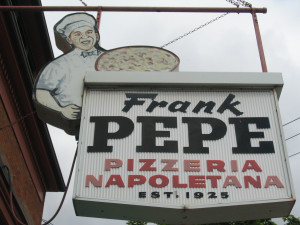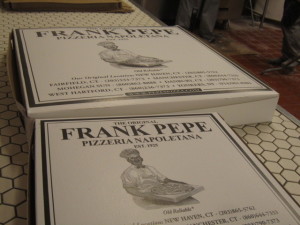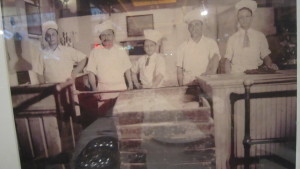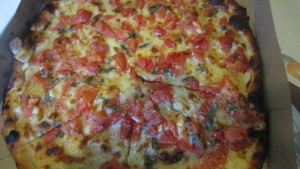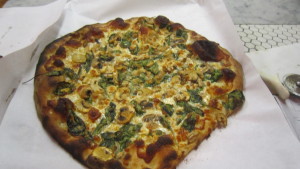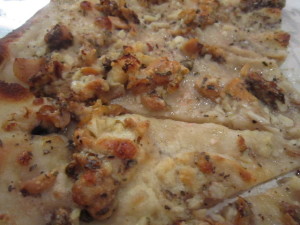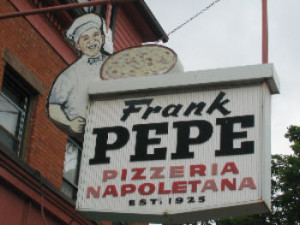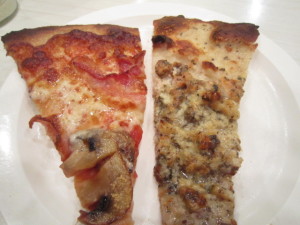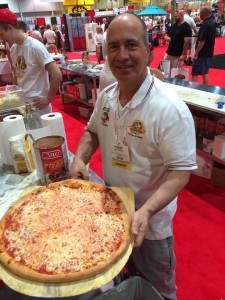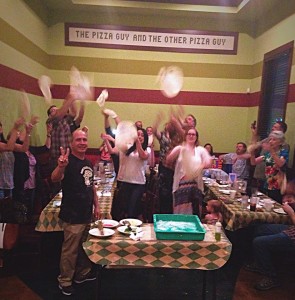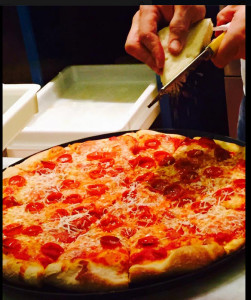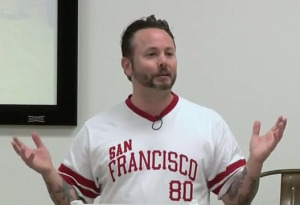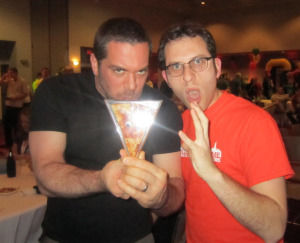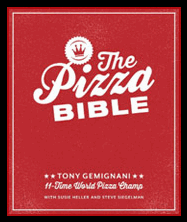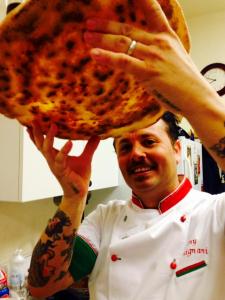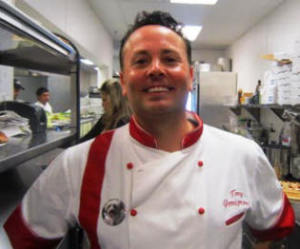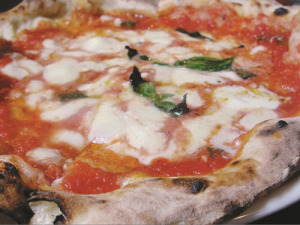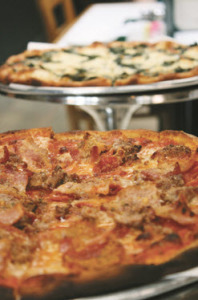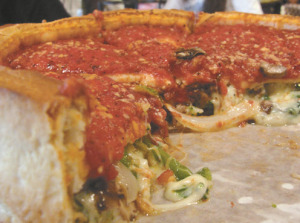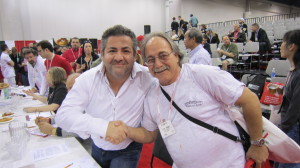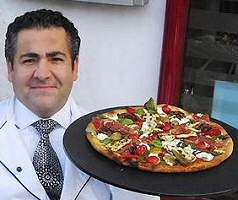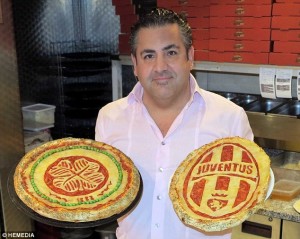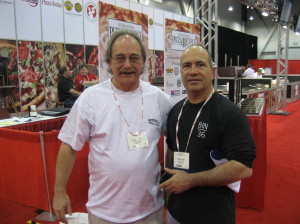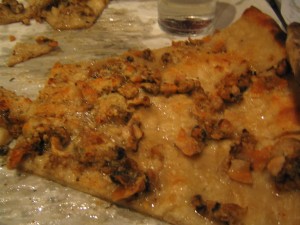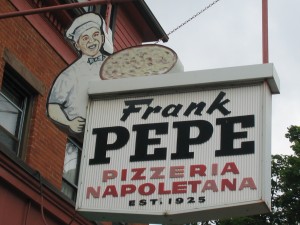[vc_row][vc_column][vc_video link=”https://www.youtube.com/watch?v=Y9_wJuwHMdc” title=”Robert Caporuscio and Tony Gemignani Make Pizza at Keste’s 10/19/17″][vc_column_text]FOR IMMEDIATE RELEASE
Pizza Powerhouses Roberto Caporuscio and Tony Gemignani to Share Neapolitan Pizza-Making Techniques and Tasting at Newest Kesté Pizza and Vino Location Collaborative Pizza Benefitting Hurricane Victims to be Unveiled (NEW YORK, NY, OCTOBER 5, 2017) — Dynamic duos of the pizza world, Roberto Caporuscio and Tony Gemingani, will join forces to ofer pizza fans an up close look at the art of Neapolitan pizza-making, along with a tasting of their crafty creations.
The one of a kind pizza presentation is taking place 6:00PM on October 19th at 66 Gold Street in the Financial District of New York City, home to the newest location of favorite pizza spot Kesté Pizza and Vino. Pizza pros Caporuscio and Gemignani, two of the most renown names in the business, bring more than four decades of pizza knowledge to the helm.
Caporuscio is one of the most highly regarded pizza chefs in the country, and the subject of rave reviews from the media, often appearing on television, at prestigious culinary events, and making masterful creations for the covers of magazines. He serves as U.S. President of the Association of Neapolitan Pizza Makers (APN), the elite Italian governing body teaching the 300-year-old art of Neapolitan pizza making, and certifying adherence to authentic procedures. The maestro, who owns four restaurants in New York City, is also Founder of the Pizza Academy Foundation (PAF) in New York City, ofering Neapolitan pizza-making classes to both professionals and novices.
Gemignani, a 12-time world pizza champion and multiple cookbook author, is a chef and owner of seventeen restaurants in Northern California and Las Vegas, and holds an impressive set of awards for his pizza-making and tossing skills. He is proprietor of the International School of Pizza in San Francisco, where he certifies chefs from around the globe, and is an ofcial U.S. Ambassador of Neapolitan Pizza by the city of Naples, a prestigious title only given to three people in the entire world. Said Caporuscio, “It’s important that the centuries-old art of Neapolitan pizza-making is preserved for generations to come. Tony and I have so much respect and passion for what we do and love to share it with others. While he’s in town from the west coast, we thought it would fun to get together and offer pizza lovers an evening of tasting and teaching.” During the event, a special pizza created by both Caporuscio and Gemignani, will be debuted and offered as a special through November at Caporuscio’s restaurants; all Kesté Pizza and Vino locations and Don Antonio.
Proceeds from the collaborative pizza, which is topped with peas, prosciutto di parma, pancetta, housemade burrata, and drizzle of local honey, will be donated to the American Red Cross’ Hurricane Irma relief fund. At the end of the evening, Gemignani will sign copies of his latest cookbook for purchase, “The Pizza Bible”, a comprehensive guide to making delicious pizzeria-style pizza at home; covering nine different regional styles, including standards such as Neapolitan, Roman, and Chicago, as well as pizza sub-specialties like St. Louis and California. Admission to the event, which is open to the public, is $25 and by reservation only, Tel. 212.693.9030 ‘
Kesté Pizza and Vino is located at 66 Gold Street (of Fulton Street), New York, NY 10038. Hours of operation are: Monday through Thursday, 10:30AM-3:30PM and 4:30PM-10:00PM, Friday through Sunday 12:00PM-11:30PM, Saturday 10:30AM-10:30PM, Tel. 212.693.9030. www.KestePizzeria.com. Other Kesté locations include 271 Bleecker Street in the West Village and 232 North 12th Street in Williamsburg, Brooklyn.
About Roberto Caporuscio: Roberto Caporuscio was born and raised on a dairy farm in Pontinia, Italy, an hour outside of Naples, where he first developed his culinary skills producing and selling cheese. However, it was in Naples, where Roberto went to study the art and craft of Neapolitan pizza-making, with the most talented pizza masters. After training, Roberto came to the United States opened several successful pizzerias, and ultimately settled in New York City in 2009 and established Kesté Pizza and Vino on Bleecker Street, followed by Don Antonio, in Midtown in February 2012, and two additional Kesté Pizza and Vino locations in Williamsburg, Brooklyn in December 2016, and in the Financial District April 2017. Roberto has become one of the most highly praised pizza chefs amongst his peers and the media, critically acclaimed “#1 Pizza in New York” by New York magazine, “Best Pizza” in the state of NY by Food Network Magazine, and amongst the top 25 “Best Pizza Places the US” by Food and Wine. His pizzas have also graced the covers of Saveur and La Cucina Italiana magazines. A passionate advocate of the Neapolitan Pizza Industry, Roberto serves as U.S. President of the Association of Neapolitan Pizza Makers (APN), the elite Italian governing body that teaches the 300 year old art of Neapolitan pizza-making, and certifies adherence to authentic procedures. The pizza maestro is the Proprietor of the Pizza Academy Foundation (PAF), and is called upon by numerous restaurants throughout the United States, for private consultations, and conducts an intensive, ten day Neapolitan pizzamaking course at which he issues APN certification to aspiring Neapolitan pizza makers/restaurateurs around the world.
About Tony Gemignani Tony Gemignani is the chef and owner of seventeen restaurants in Northern California and Las Vegas and a 12-time world pizza champion. Born and raised in Fremont, California, he is the first and only Triple Crown winner for baking at the International Pizza Championships in Lecce, Italy; and, his most prestigious title to date, is 2007 World Champion Pizza Maker at the World Pizza Cup in Naples, Italy, where he was the first American and non-Neapolitan victor. Tony has also been inducted three times into the Guinness Book of World Records for creating the world’s largest pizza, for accomplishing the most consecutive rolls across the shoulders, a unique pizza dough throwing trick, and for creating the world’s longest pizza in 2017. Tony is president of the World Pizza Champions, and an ofcial U.S. Ambassador of Neapolitan Pizza by the city of Naples, a prestigious title only given to three people in the entire world.
He is also the first Master Instructor in the United States from the Scuola Italiana Pizzaioli and is the proprietor of the International School of Pizza where he certifies chefs from around the world. Tony has appeared on a number of popular shows, including taking home the gold medal at the Food Network Pizza Champions Challenge. In an efort to share his talent and passion with aspiring connoisseurs, Tony collaborated with acclaimed cookbook writer, Diane Morgan, on his first cookbook PIZZA.
Following the success of PIZZA, he wrote Tony and the Pizza Champions and most recently, The Pizza Bible, the definitive book on pizza. About Kesté Pizza and Vino Gold Street The newest location of Kesté Pizza and Vino, 66 Gold Street in the Financial District of New York City, opened April 2017.
Combining historic architectural elements such as aged woods, ceramics from the Amalfi Coast, carved Lecce stone (a unique limestone from Italy’s Apulia region), brick and copper details, the 150 seat restaurant emulates the style of traditional Neapolitan pizzerias from the 1800s.
At Kesté, which means “this is it” in Neapolitan dialect, pizza fans can indulge in an expansive assortment of more than 60 traditional and creative wood-fired Neapolitan pies crafted from the finest ingredients, including homemade mozzarella. In addition to several red, white, fried and specialty pizzas, the menu also showcases an assortment of gluten free pizzas, and several vegetarian/vegan options. The full-service bar, features a list of carefully selected Italian wines and beers as well as specialty cocktails.
Telephone: 212-693-9030
Keste Pizza and Vino
Contact: Dana L. Stott
DLS Public Relations
Telephone: (202) 981-0463
Dana@DSLPublicRelations.com
[/vc_column_text][vc_single_image image=”2777″ img_size=”medium”][vc_single_image image=”1850″ img_size=”medium” add_caption=”yes”][vc_raw_html]JTNDYSUyMHRhcmdldCUzRCUyMl9ibGFuayUyMiUyMGhyZWYlM0QlMjJodHRwcyUzQSUyRiUyRnd3dy5hbWF6b24uY29tJTJGZ3AlMkZwcm9kdWN0JTJGMTYwNzc0NjA1MCUyRnJlZiUzRGFzX2xpX3RsJTNGaWUlM0RVVEY4JTI2Y2FtcCUzRDE3ODklMjZjcmVhdGl2ZSUzRDkzMjUlMjZjcmVhdGl2ZUFTSU4lM0QxNjA3NzQ2MDUwJTI2bGlua0NvZGUlM0RhczIlMjZ0YWclM0RwaXp6YXRoZXJhcHktMjAlMjZsaW5rSWQlM0Q0MjJjZGM5ODBhNzdiM2FiNWJjODAwNTRkN2IxNmIxNSUyMiUzRVRoZSUyMFBpenphJTIwQmlibGUlM0ElMjBUaGUlMjBXb3JsZCUyN3MlMjBGYXZvcml0ZSUyMFBpenphJTIwU3R5bGVzJTJDJTIwZnJvbSUyME5lYXBvbGl0YW4lMkMlMjBEZWVwLURpc2glMkMlMjBXb29kLUZpcmVkJTJDJTIwU2ljaWxpYW4lMkMlMjBDYWx6b25lcyUyMGFuZCUyMEZvY2FjY2lhJTIwdG8lMjBOZXclMjBZb3JrJTJDJTIwTmV3JTIwSGF2ZW4lMkMlMjBEZXRyb2l0JTJDJTIwYW5kJTIwbW9yZSUzQyUyRmElM0UlM0NpbWclMjBzcmMlM0QlMjIlMkYlMkZpci1uYS5hbWF6b24tYWRzeXN0ZW0uY29tJTJGZSUyRmlyJTNGdCUzRHBpenphdGhlcmFweS0yMCUyNmwlM0RhbTIlMjZvJTNEMSUyNmElM0QxNjA3NzQ2MDUwJTIyJTIwd2lkdGglM0QlMjIxJTIyJTIwaGVpZ2h0JTNEJTIyMSUyMiUyMGJvcmRlciUzRCUyMjAlMjIlMjBhbHQlM0QlMjIlMjIlMjBzdHlsZSUzRCUyMmJvcmRlciUzQW5vbmUlMjAlMjFpbXBvcnRhbnQlM0IlMjBtYXJnaW4lM0EwcHglMjAlMjFpbXBvcnRhbnQlM0IlMjIlMjAlMkYlM0U=[/vc_raw_html][/vc_column][/vc_row][vc_row][vc_column][vc_raw_html]JTNDaWZyYW1lJTIwc3R5bGUlM0QlMjJ3aWR0aCUzQTEyMHB4JTNCaGVpZ2h0JTNBMjQwcHglM0IlMjIlMjBtYXJnaW53aWR0aCUzRCUyMjAlMjIlMjBtYXJnaW5oZWlnaHQlM0QlMjIwJTIyJTIwc2Nyb2xsaW5nJTNEJTIybm8lMjIlMjBmcmFtZWJvcmRlciUzRCUyMjAlMjIlMjBzcmMlM0QlMjIlMkYlMkZ3cy1uYS5hbWF6b24tYWRzeXN0ZW0uY29tJTJGd2lkZ2V0cyUyRnElM0ZTZXJ2aWNlVmVyc2lvbiUzRDIwMDcwODIyJTI2T25lSlMlM0QxJTI2T3BlcmF0aW9uJTNER2V0QWRIdG1sJTI2TWFya2V0UGxhY2UlM0RVUyUyNnNvdXJjZSUzRHNzJTI2cmVmJTNEYXNfc3NfbGlfdGlsJTI2YWRfdHlwZSUzRHByb2R1Y3RfbGluayUyNnRyYWNraW5nX2lkJTNEcGl6emF0aGVyYXB5Y3liZSUyNm1hcmtldHBsYWNlJTNEYW1hem9uJTI2cmVnaW9uJTNEVVMlMjZwbGFjZW1lbnQlM0QxNjA3NzQ2MDUwJTI2YXNpbnMlM0QxNjA3NzQ2MDUwJTI2bGlua0lkJTNEZDA1NjViN2M3MTY0NWU0NTFmY2I3MjBjODgyNTlkYWMlMjZzaG93X2JvcmRlciUzRHRydWUlMjZsaW5rX29wZW5zX2luX25ld193aW5kb3clM0R0cnVlJTIyJTNFJTNDJTJGaWZyYW1lJTNF[/vc_raw_html][/vc_column][/vc_row][vc_row][vc_column][vc_raw_html]JTNDaWZyYW1lJTIwd2lkdGglM0QlMjcyNTAlMjclMjBoZWlnaHQlM0QlMjczNTAlMjclMjBzcmMlM0QlMjdodHRwcyUzQSUyRiUyRnd3dy5zdW5mcm9nLmNvbSUyRndpZGdldCUyRnNmd2lkZ2V0LmNmbSUzRjQ0NzY3JTI2Y3QlM0QlMjZrZXklM0QlMjZidG4lM0Q0JTI2YnRudHh0JTNEQ2xhaW0lMjBUaGlzJTIwTm93JTI2Y29sJTNEMTQyODglMjclMjBmcmFtZWJvcmRlciUzRCUyNzAlMjclMjBhbGxvd2Z1bGxzY3JlZW4lMjBzY3JvbGxpbmclM0QlMjdubyUyNyUzRSUzQyUyRmlmcmFtZSUzRQ==[/vc_raw_html][/vc_column][/vc_row]


